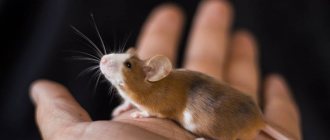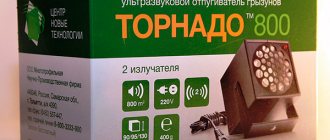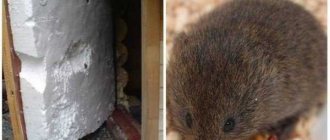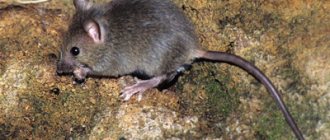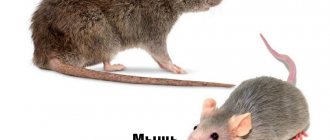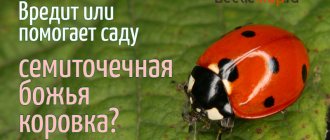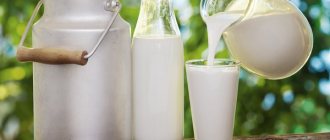In gardens where all agrotechnical measures are carried out on time (digging, weed control, etc.), rodents are much less common compared to gardens where the soil is neglected and littered with various debris, old manure, and plant debris. Voles mostly damage young apple trees by gnawing on the bark, which is a conductor of water and nutrients for the tree. This means that the more the bark is damaged, the worse the tree develops. And its yield in comparison with similar apple trees will be significantly lower.
And if in spring, summer and autumn a gardener fights pests, including codling moths, moths, scale insects, aphids and others, then with the onset of cold weather it is necessary to protect the garden from rodents migrating due to lack of food in the natural environment to people’s homes. The part of the trunk that is under the snow is especially often damaged by mice. We will tell you how to reanimate trees after a rodent invasion in this article.
Uninvited guests in the apple orchard
Some visitors may never be seen in person, but traces of their presence are immediately evident. As a rule, this happens in the spring: the snow melts, tree trunks are exposed, on which four-legged visitors have left their creepy “autographs”.
Mice
Voles are regular visitors to the orchard during the winter season. Only in spring their presence is revealed by the mutilated bark of trees, primarily apple trees. The largest representative of voles among them is the water vole, its body length varies from 12 to 20 cm. Representatives of other species are smaller, on average from 8 to 12 cm. Mice are very prolific, if no measures are taken, any vegetation in the garden, whether the garden may be in danger of destruction. Voles give birth to offspring several times a year. There are from 4–5 to 14 mice in a litter, and in some years the number of rodents reaches 2 thousand individuals per 1 hectare. Animals create a system of passages underground and on its surface. The entrances to ground nests are perfectly camouflaged; it is completely impossible to see them.
Damage to apple trees from mice is terrible because it is often discovered late. Bare areas of the trunk become vulnerable to winter frosts, especially if they alternate with thaws. If the garden is located near the house, you can periodically check whether the bark is intact, trample the snow in the tree trunks, blocking the movement of rodents. But it is not always possible to get to a dacha outside the city at the right moment, and it is impossible to guess this very moment. Rodents grind the pliable bark of young and middle-aged apple trees from the root collar and up the trunk. In winter, they make tunnels under the snow, raking it with their front paws and head. The higher the snowdrifts, the higher the damage will be, right down to the skeletal branches. The sharp mouse incisors also attack the roots of apple trees located closer to the surface of the earth, buried seedlings and cuttings.
Tree treatment
Mice usually do not cause much damage to trees. Of course, if there is no ring eating of the bark. Then the young tree may simply die. To prevent voles from entering the plantings, it is advisable to trample the snow around the trunks after any snowfall, and to keep the garden clean in other seasons. But if in the spring a gardener, walking around and inspecting the plantings, notices that mice have chewed the bark of some tree, then it is necessary to immediately begin saving the apple tree. A damaged tree becomes susceptible to various diseases such as cytosporosis, sooty fungus and scab.
The tree treatment method is selected depending on the degree of damage to the tree.
Garters
In case of minor injuries, wounds can be healed with bandages. True, they will only be effective on fresh wounds that have not begun to dry out. In the event that the tree’s cambium is not damaged and the damage is not circular. The most common dressing methods:
- Lubricate the wound with Heteroauxin ointment. Apply garden varnish on top, wrap the area with cloth, and secure a piece of polyethylene on top;
- Wash the wounds with linden decoction, tie them with cloth, and put polyethylene on top. This dressing should last the whole summer;
- Treat damaged areas with a clay mash. It is prepared from six parts clay and four parts manure. Dilute in water to the consistency of a thick dough. Apply a thick layer to the wound. They wait until it dries a little, then they tie a cloth around the area and reapply a ball of clay. The bandage is not removed until spring. If everything is done correctly, then by the beginning of the growing season you will notice that the damage has been healed by the young bark;
- In stores selling gardening tools and preparations you can buy ready-made bactericidal putty “Rannet”. It should be applied to the damaged bark. When the drug dries, it forms a protective film;
- A three percent solution of copper sulfate will disinfect the wound well and help it heal. It is applied several times to the wound, and then the area is wrapped with black agrofibre or polyethylene of the same color.
Also read about methods of controlling bark beetles on apple trees at this link.
Grafting the wound
Wound grafting is used for severe injuries when the cambium is damaged. Sequence of grafting an apple tree with a bridge:
- The damaged area is cleaned very carefully;
- Disinfect with a one percent solution of copper sulfate;
- Last year's young shoots are cut into equal sections, which should be 5–6 cm larger than the wound;
- The ends are cut so that an acute angle is formed on both sides, all buds are removed from them;
- At the top and bottom of the damage, cuts are made in the bark in the shape of the letter T;
- The cuttings are inserted into them with sharp ends;
- If the tree is old, then there may be 5 or more such bridges. For a young apple tree, 1–2 cuttings are enough.
Read about apple tree grafting in spring for beginners here.
Figure: Methods of grafting an apple tree for treatment against damage by rodents.
The graft needs to be secured with a cloth or even small “parcel” nails driven in.
Engraftment of the cortex
Experienced gardeners know this method, but it will not be difficult for beginners to master it. Its essence is to graft the bark onto a bare area of the trunk that has been chewed off by mice. To perform this action you will need a sharp knife. A patch is cut from a donor tree or from a thick branch of the same apple tree. Its size should be five centimeters larger on each side than the wound left by rodents. Then the patch is applied to the affected area and wrapped well with insulating tape. In order for the tree to recover and not die, it must be looked after. Water and feed with the necessary fertilizers. Before the start of winter, the electrical tape can be removed.
This article will tell you how to seal a hollow in an apple tree.
It is necessary to cut the patch for replanting with a very sharp knife carefully and carefully so as not to harm the donor apple tree and, of course, not to injure your fingers.
Cutting the trunk for reverse growth
If the trunk of the tree has been very badly damaged by mice, the apple tree can only be saved by using drastic measures.
To do this, the entire tree is cut down above the lower bud of the trunk. This must be done before the sap flow begins, and this is an important rule. The cut on the stump is covered with garden varnish. If the apple tree was healthy, with a good root system, then by spring it will produce dense shoots. How to cover a saw cut on an apple tree is described in detail here.
From it you can choose the strongest and most suitable future trunk for the renewed tree.
As a rule, this method can help apple trees that are five years old or more. Young seedlings still have a very weak root system and the likelihood that after cutting down a trunk damaged by mice the tree will sprout is small.
Photo gallery: species of voles that gnaw apple trees
The entrance to a water vole's burrow is almost impossible to notice.
The field vole is difficult to distinguish due to its dark fur
The bank vole lives non-stop 24 hours a day
During the day, the common vole eats food equal to 50–70% of its body weight
Forest guests
The white hare is small, in summer it feeds on grass and herbaceous plants, but in winter it raids gardens, eating apple trees, buds on old trees, and young shoots on seedlings. An apple tree is a delicacy for him, but if he gets hungry, he will gnaw off all the trees in sight. The brown hare eats the same things as the hare; stays in open places: fields, forest edges, loves to look into the garden. It is difficult to keep track of the animals, because their activity occurs in the dark, and on a moonlit night, hares can feed until the morning. Although the hare no longer belongs to the order of rodents, it gnaws the bark of many trees thanks to its powerful front teeth - incisors. And if mice work like a jeweler, more or less evenly removing a layer of bark, then hare gnaws are rough, deep and long.
A hare's teeth are powerful and grow throughout its life.
Effective protection against hares is a net or any other material wrapped around the trunk to a height of at least 1.5 m. Why so high? The body length of the hare is 45–47 cm, the hare is 55–67 cm. Add here the length of the hind legs, which is almost equal to the length of the body (and the hare can stand “on tiptoes,” significantly increasing in height). The higher the snowdrift, the greater the damage to the bark.
Standing on its hind legs, the hare significantly increases in height and damages trees to a height of more than 1 meter
By the way, I prepared the apple trees in the fall by wrapping the bases of the trunks with nylon tights, but this year there was more snow than ever, and the hares gnawed the trunks above the wrapped one.
izid
https://www.websad.ru/archdis.php?code=570534
For me, there is no creature worse than mice and hares than an ordinary domestic goat - the most malicious garden pest from early spring to late autumn. These insidious creatures with amazing insight find the slightest loopholes to get to the coveted plants. From my sad experience, I remember a November day when four neighbor’s goats, left unattended by the owner, entered my front garden through a slightly open gate (but that’s a different story). In just a few minutes they managed to taste rose bushes with huge thorns, lilacs and my favorite Golden Delicious. Everything was eaten, gnawed and broken off with barbaric cruelty, and my emotional experiences at that moment were beyond description. Subsequently, only a strong high fence and a bolted gate protected my plantings from the encroachments of horned beasts.
Goats seem to be able to climb any tree.
Restoring damaged roots
If mice and rats have gnawed through the roots of young plants under 5 years old, there is only one rescue strategy. This is careful treatment of wounds and slow recovery with balancing of roots and crowns, installation of supports and partial replacement of the substrate with special soil mixtures.
On plants with eaten roots (if no more than 80% of the roots are damaged), a complete root treatment procedure is carried out in the spring:
- dig out and rake away the soil, exposing the rhizome;
- all wounds, eaten and gnawed areas are treated with a solution of a fungicide, growth stimulator and thoroughly treated with ash;
- a reliable support is installed for the plant, which will serve as additional support for several years;
- add wood ash (2.5-3 l) and superphosphate (250-300 g) to the soil, fill the plant and carefully compact the soil, carefully filling the space between the roots;
- The crown is pruned, trying to leave as many branches as there are intact roots left (if 80% of the root system is damaged, cut out 80% of the branches, etc.). The root system and crown must be balanced; leave only strong, healthy skeletal shoots;
- For several winter seasons, the fruit tree is protected from rodents and frost more thoroughly.
Trees with damaged roots recover slowly, first growing rhizomes and then crowns.
How to protect your garden from mice and hares
It will not be possible to remove mice from the site in any one way - it is advisable to combine preventive or proactive measures with “forceful” methods.
Prevention of mice
The garden area must be kept clean:
- burn branch cuttings;
- dispose of remaining weeds after weeding;
- dig in or store dry leaves and food scraps in a compost heap;
- uproot stumps.
There is no need to arrange a warehouse for building materials, especially wooden ones, in the garden. Because the slightest gap between the boards or beams can be chosen by a miniature animal as a “house”.
Mice gnaw not only tree trunks, but also get to the roots
To repel mice, plants with a specific aroma that is unpleasant to the mouse sense of smell are used:
- tops of black root, tomato, branches of black elderberry. This material is used to cover the trunk circle or tie the trunk;
- autumn crocus (colchicum, autumn crocus or autumn crocus). It grows in the southern and western parts of Russia, blooms in August - September. Ground plant seeds (20 g) are mixed with 1 kg of cereal and placed in places where mice appear;
- wild rosemary. The plant has a pronounced aroma, as they say, not for everybody. Mice can't stand it. Ledum leaves are used to clog the entrance to the hole;
- thuja, spruce. Prepare an infusion: 0.5 kg of plant branches are poured into 10 liters of boiling water. The resulting aromatic liquid is poured into the minks. The trunk of the apple tree is tied with spruce branches, tops down;
- burdock heads. Green or mature prickly balls are laid out at the entrance to the burrow;
- daffodils. Mice do not like flower bulbs, so an elegant flower can act not only as a garden decoration, but also as a kind of barrier for rodents;
- Euphorbia chin is an exotic plant for the Middle Zone, but typical in Transcaucasia and the Krasnodar Territory. Sprigs of milkweed are poisonous, they are twisted into a ball and stuck into a hole, the mice then leave;
- celandine - crushed, used as mulch both in the tree trunk and in the beds.
Mice are repelled by the scent of certain plants or the toxic substances they contain.
In my front garden there is a four-year-old dwarf apple tree. Its bark is in excellent condition from top to bottom, because the trunk circle is bordered by luxurious daffodil bushes. I think the mice have gotten into the habit of avoiding this place.
Beautiful protection from daffodils
Baits and poisons
Various kinds of baits are produced especially for mice, for example, Euroguard, Anti-rat, Ratobor, Ratcatcher, Nutcracker. The main inconvenience of their use is that in addition to mice, birds, hedgehogs, a beloved cat or, God forbid, curious small children can be poisoned. It is necessary to regularly check and remove rodent corpses, while simultaneously improving the art of masking the poison from others. Baits prepared at home may not have such a lethal effect, but are harmless to people:
Recent Entries
Lilac perennials that are beautiful, compact and do not crowd out other plants Why when buying seedlings you should not take the sellers’ word for it and how to determine the age of the plant using 3 signs Tomato seedlings have turned purple or whitish: why the color has changed and how to save the plants
- flour, sugar, alabaster or cement, taken in equal quantities;
- black bread and alabaster or plaster in a 1:1 ratio.
The ingredients are mixed with dry hands so that the alabaster and other additives do not harden ahead of time. The mass is rolled into small balls, placed in paper bags and pushed into the hole. Thus, mice gnaw the bait underground, and indigestible food will be inaccessible to living creatures on the surface. Once in the animal's body, alabaster, plaster or cement hardens and clogs the gastrointestinal tract, causing the mouse to die.
The use of poisoned baits poses a risk to other animals and children
Protective equipment made from scrap materials
An excellent protection for apple tree trunks from mouse teeth is a mesh - a special one or purchased at a building materials store. The main thing is that the cells are small. The fact is that the bones of the mouse are movable, thanks to which it can fold like a transformer and penetrate small holes. The lower edge of the mesh fence is dug 10–20 cm into the ground so that mice do not damage the root collar and roots located near the surface of the ground.
We determine the extent of damage and risks
To find the optimal strategy for restoring damaged fruit trees and other seedlings damaged by rodents, it is worth determining the degree of damage caused to the plant. Rodents can:
- partially gnaw off the bark on the trunk;
- gnaw the bark on the trunk around the circumference (in a ring);
- eat skeletal and small twigs;
- damage the roots (most often damage appears only in the spring, when trees fall over and are easily pulled out);
- gnaw through the root collar tissue.
All types of damage, even small ones, put trees at risk of frostbite, infection, disrupt sap flow and cause drying out, not to mention a decrease in stability and yield.
The chances and timing of saving the plant are influenced by two factors:
- condition of the cambium (is the cambium damaged and has the drying process begun?);
- affected area.
Only trees that have not had at least part of their bark gnawed off (at least 20% of the bark and roots should remain) should be saved. The smaller the area of damage, the higher the likelihood that the seedling will survive and recover over the years. Serious risk of plant death - more than 50% of bark or roots damaged or any ring lesion.
To choose the optimal strategy for restoring seedlings damaged by rodents, it is worth determining the degree of damage caused to the plant
The essence of the problem
The bark for each tree is a transport route through which water and nutrients are delivered to all its parts. Therefore, the development of the apple tree and its productivity directly depend on the condition of the outer covering of the trunk.
However, this fruit tree has many enemies that cause harm in all seasons. Insects that fly in spring are replaced by crawling and sucking insects that damage leaves, shoots and fruits. And even in winter, the apple tree can be damaged. At this time, she is threatened by rodents who move to summer cottages due to lack of food in forests and fields. Here you can always find food in the form of fallen fruits that have not been removed from the site or food debris in the compost heap.
Rodents also like apple tree bark. Mice easily make passages in the snow and get to the trunk. The gardener discovers damage, in most cases, only in the spring after the snow melts. And if they are not significant, then in general nothing threatens the apple tree: nutrition and moisture will flow into the crown through the preserved part of the bark. But the tree cannot be left without attention and care.
It is much worse if the bark is gnawed all around. In this case, the tree’s nutrition is completely disrupted and significant efforts will be required to help the tree cope with the problem.
Prevention measures
Gardeners cannot predict whether rodents will come to the site. All that is possible is to make their life on the site impossible. To do this you will need:
- remove the tree trunk in the fall so that nothing attracts rodents;
- burn organic waste;
- dig up the soil under the tree;
- carry out whitewashing in the fall.
A preventative measure in the fight against rodents is whitewashing the apple tree.
If you try to carry out all preventative measures in the fall and use tips on how to protect young apple trees, then you won’t have to treat them.
A tree that has damaged part of its bark needs special care. His immunity is weakened, so he will need protection from diseases and pests.
Why is damage to the bark of apple trees dangerous?
Small mice can disrupt plans for a high-quality harvest next year, into which a lot of effort has been invested. Bark is their favorite treat; if you don't take care of your garden in winter, it can be damaged beyond repair. Of all garden trees, the most favorite are apple trees, especially young ones with soft bark.
It is possible to save a tree with damaged bark, but you need to act immediately. It is important to make every effort to preserve garden “pets” so that in the future they will delight you with a good harvest. Only timely protection will prevent garden plants from dying. It is important to carry out annual preventative maintenance.
Graft
If the apple tree has received significant damage from rodents, applying bandages will no longer help; in this case, bridge grafting can help. Of course, if the cambium is damaged, it will be more difficult to help the apple tree, but you still need to try. Here's how this vaccination is done:
- The wound should be thoroughly cleaned down to wood.
- The barrel is treated with 1% copper sulfate.
- Several shoots from last year are cut from the apple tree and cut so that their size exceeds the size of the wound by 5 cm.
- The resulting cuttings are pruned on both sides. The cutting angle must be sharp.
- The bark above and below the wound is cut in the shape of the letter “T”.
- The cuttings are inserted into the cuts.
To treat young apple trees, 2 shoots will be enough. For older people - at least 5. After this procedure, the treatment site is lubricated with varnish and a bandage of fabric and polyethylene is applied to it. The shoots inserted into the cuts will take root after some time and will serve as cambium. After a few years, the area will be leveled, and the cut shoots will completely grow together with the tree.
Engraftment method
Carrying out this procedure will not be easy, and only experienced gardeners can do it. This method is used when there is significant damage to the bark, when it has been chewed all around and there is not a single undamaged area left.
For this you will need a donor apple tree. As a last resort, you can use the bark from the same apple tree, but you need to choose a thicker branch for removing the bark. The bark is removed with a sharp knife. This should be done as carefully as possible. The patch should be 5 cm larger than the wound on all sides, and it is fixed with electrical tape. Remove it after the onset of cold weather.
Attention! Of course, there are cases when an apple tree recovers completely after damage, but this happens extremely rarely. Usually, after serious damage, fruiting deteriorates, and recovery is long and painful.
Video
We invite you to watch a few more recommendations from experienced gardeners in the following videos:
Author: Bugaeva Alexandra
Found a mistake? Select the text with the mouse and click:
“Frost-resistant” varieties of garden strawberries (more often simply “strawberries”) need shelter just as much as ordinary varieties (especially in those regions where there are snowless winters or frosts alternating with thaws). All strawberries have superficial roots. This means that without shelter they freeze to death. Sellers’ assurances that strawberries are “frost-resistant,” “winter-hardy,” “tolerates frosts down to −35 ℃,” etc. are deception. Gardeners must remember that no one has yet managed to change the root system of strawberries.
One of the most convenient methods for preparing a harvest of vegetables, fruits and berries is freezing. Some believe that freezing causes the nutritional and health benefits of plant foods to be lost. As a result of the research, scientists have found that there is practically no decrease in nutritional value when frozen.
In Australia, scientists have begun experiments in cloning several varieties of grapes grown in cold regions. Climate warming, which is predicted for the next 50 years, will lead to their disappearance. Australian varieties have excellent characteristics for winemaking and are not susceptible to diseases common in Europe and America.
It is believed that some vegetables and fruits (cucumbers, stem celery, all varieties of cabbage, peppers, apples) have “negative calorie content,” that is, more calories are consumed during digestion than they contain. In fact, only 10-20% of the calories received from food are consumed in the digestive process.
Both humus and compost are rightfully the basis of organic farming. Their presence in the soil significantly increases the yield and improves the taste of vegetables and fruits. They are very similar in properties and appearance, but they should not be confused. Humus is rotted manure or bird droppings. Compost is rotted organic remains of various origins (spoiled food from the kitchen, tops, weeds, thin twigs). Humus is considered a higher quality fertilizer; compost is more accessible.
You need to collect medicinal flowers and inflorescences at the very beginning of the flowering period, when the content of nutrients in them is highest. Flowers are supposed to be picked by hand, tearing off the rough stalks. Dry the collected flowers and herbs, scattered in a thin layer, in a cool room at natural temperature without access to direct sunlight.
A new product from American developers is the Tertill robot, which weeds weeds in the garden. The device was invented under the leadership of John Downes (creator of the robot vacuum cleaner) and works autonomously in all weather conditions, moving over uneven surfaces on wheels. At the same time, it cuts off all plants below 3 cm with the built-in trimmer.
The homeland of pepper is America, but the main breeding work on developing sweet varieties was carried out, in particular, by Ferenc Horvath (Hungary) in the 20s. XX century in Europe, mainly in the Balkans. Pepper came to Russia from Bulgaria, which is why it received its usual name - “Bulgarian”.
conclusions
A young orchard often suffers from damage by rodents. As a result of the resulting wounds, the integrity of the internal conductive layer of the bark - cadmium, on the functioning of which depends on the flow of sap and the life of the tree. If the wounds are not healed, this can lead to the death of the plant. That is why it is recommended to immediately begin treatment using the methods described in the article, as well as carry out preventive measures to protect the garden.
Previous
Pests
